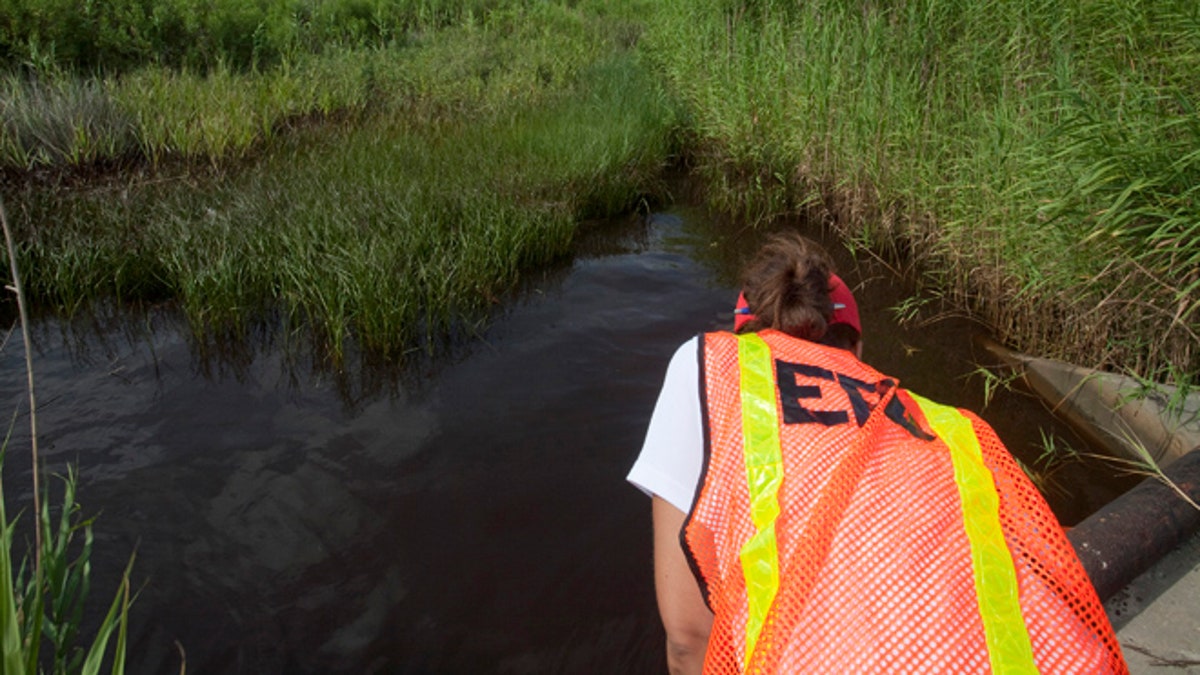
In this July 7, 2010 file photo, an EPA worker looks at oil from the Deepwater Horizon spill which seeped into a marsh in Waveland, Miss. (Reuters)
Attorneys general in 21 states are fighting to block Environmental Protection Agency pollution limits designed to improve the health of the Chesapeake Bay, fearing the Obama administration will use that authority to regulate wetlands in their states.
The attorneys general filed an amicus brief earlier this month in support of the American Farm Bureau Federation's challenge to the cleanup plan, which aims to reduce pollutants and get the bay up to federal clean-water standards by 2025, the Atlanta Journal-Constitution reported.
The states argue that the effort is "the culmination of (the EPA's) decade-long attempt to control exactly how states achieve federal water quality requirements under the (Clean Water Act), and marks the beginning of the end of meaningful state participation in water pollution regulation."
In September, a judge dismissed a bid by the farm bureau and other industry groups to block the plan, finding that the cleanup did not violate the Clean Water Act because the EPA and the states involved all agreed to it and were given the flexibility to decide how to meet the limits.
While the EPA has the power to establish a maximum amount of a pollutant allowed to enter a body of water, the 21 states argue the Clean Water Act does not give the agency the authority to regulate individual pollutants from individual sources, the Journal-Constitution reported.
According to The Washington Post, the EPA recently lost its challenge to a lawsuit filed by environmental groups that called on the agency establish new water quality standards for the Mississippi River and to develop a "measuring stick" for the level of pollution that could be allowed to enter the river.
The Chesapeake Bay Foundation, which intervened in the original lawsuit in support of cleanup efforts at the bay, praised the progress made by bay states and the federal government to achieve clean water in local watersheds.
“We say to Missouri, Indiana, Kansas, Alaska and the other 17 states, don’t tell us how to restore clean water in our backyard," the group said in a statement to the Star-Democrat. "Each of the six Bay states and the District of Columbia — including hard working farmers, businesses and individuals — are cooperating. Together, we are well on our way to making our rivers and streams safer, improving habitat, protecting human health and strengthening local economics."
Agriculture groups have also joined the fight against the plan, saying it unfairly singles out farmers and the cost to protect waterways from runoff could devastate farmers. The National Association of Home Builders also challenged the Chesapeake Bay plan in 2011.
Farm runoff — such as animal waste and fertilizer that get into streams and rivers from watering or rainfall — is the single largest source of pollutants in the Chesapeake Bay, according to the EPA.
In announcing it would appeal last fall's court decision, American Farm Bureau President Bob Stallman said the case has "dangerous implications for farmers and many others in the Chesapeake Bay area and nationwide."
"Win or lose on appeal, farmers and ranchers will continue their dedicated efforts on the farm to improve water quality and the natural environment. In the meantime, AFBF will continue to oppose what we see as a remarkable power grab," Stallman said at the time.
State-federal efforts to improve the Chesapeake Bay water quality stretch back 30 years to 1983, when the governors of Maryland, Virginia and Pennsylvania, the mayor of Washington, D.C., and the head of the EPA signed the first "Chesapeake Bay Agreement."
After years of missing deadlines, the EPA and six states — Delaware, Maryland, New York, Pennsylvania, Virginia and West Virginia — and Washington, D.C., agreed in 2007 to establish a pollution-reduction program by May 1, 2011, and to reach the targeted limits by 2025.
The states challenging the plan are Michigan, Florida, Alabama, Arkansas, Georgia, Indiana, Kansas, Kentucky, Louisiana, Missouri, Nebraska, North Dakota, Oklahoma, South Carolina, South Dakota, Texas, Utah, West Virginia and Wyoming, according to The Washington Post.
The Associated Press contributed to this report.




